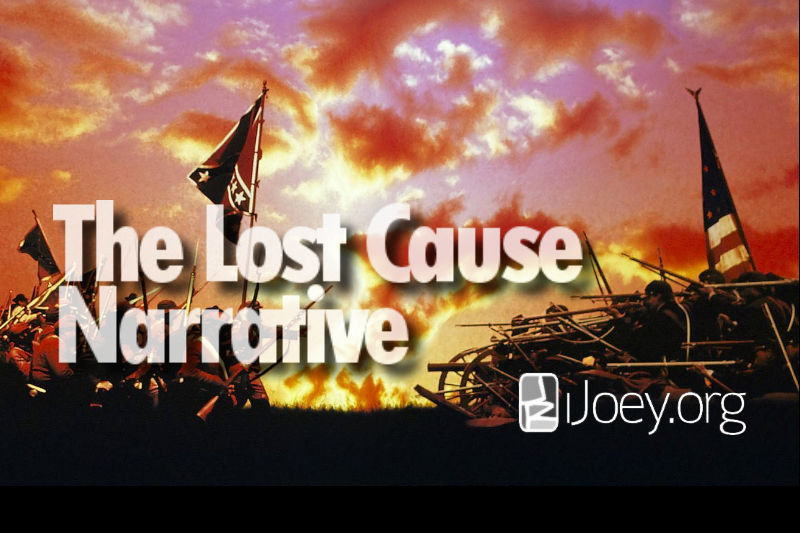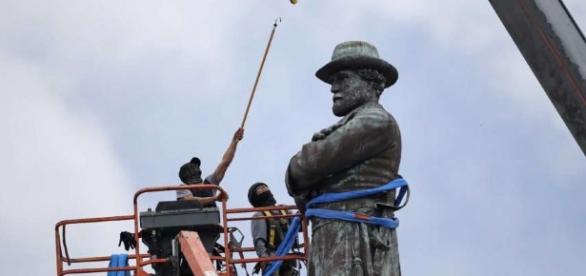In the first post in this series, I shared my early understanding of the Civil War and the picture of history that had been painted for me. In the second post, I outline my discovery of actual records and documents deepened my dismay. In the third post, I described my reaction to some of the political speeches and memoirs of Southern leaders and detail how they helped to end my belief in the Lost Cause narrative. This fourth and final post in the series draws some conclusions about the Lost Cause narrative and the errors we continue to make.
Part One | Part Two | Part Three | Part Four
The False Narrative Continues
History is a fluid thing. Events are factual. Reports on these facts can and do vary. Beyond these difficulties, there is the problem of interpretation. Given the vital need to repair the breach in our still burgeoning nation, the Lost Cause narrative, though lamentable and regrettable now, made some semblance of sense at the time. Over time, it became the grounds for a second civil religion according to Charles Reagan Wilson. In his book, Baptised in Blood, he describes the Lost Cause in great detail. In the following quote from that book, you will see how the Church was compromised to accomplish the goal of the Lost Cause.
In The Lost Cause (1866), the Richmond editor Edward A. Pollard called for a “war of ideas” to retain the Southern identity. The South’s religious leaders and laymen defined this identity in terms of morality and religion: in short, southerners were a virtuous people. Clergymen preached that southerners were the Chosen people, peculiarly blessed by God. “In a word,” says Samuel S. Hill, a leading historian of Southern religion, “many southern white have regarded their Society as God’s most favored. To a greater degree than any other, theirs approximates the ideals the Almighty has in mind for mankind everywhere.”
This attitude helped wed southern churches to southern culture. As Hill points out, the “religion of the Southern people and their culture have been linked by the tightest bonds. That culture, particularly in its moral aspect, could not have survived without the legitimating impetus provided by religion. The coexistence help enable southern values and institutions to survive in the face of internal spiritual contradictions and external political pressures pressures. For the South to stand, its people had to be religious and its churches the purest anywhere.” Unfortunately the self image of a chosen people leaves little room for self criticism. This deficiency has led to the greatest evils of the religion-culture link in the south.
Where does this leave the Church today? To put it simply, church leaders must call for self-criticism and self-examination to find those faults within our culture that we have been taught to ignore. We must especially seek out those we have been taught to glorify. Once we do this, we can see, through the benefit of hindsight, that this willingness to gloss the evils of sedition and slavery has only served to empower those who would embrace the evils of racism and bigotry.
The Lost Cause narrative has made us unwilling accomplices in the cause of white supremacy. Poll after poll indicate that we decry the efforts of white supremacists. Most of us find them to be lazy thinkers and people who parlay ignorance into power. But the efforts of the Church, in the South particularly, to glorify and honor the political and military leaders of the confederate states only serve to strengthen the positions of these same people. Moreover, our reverence for these “heroes” is based on a myth that has little basis in evidence.
Though we are unwilling accomplices to white supremacy, we are often willing accomplices in the erection and preservation of these statues. And because these statues had a more nefarious purpose, we must be plain about our role in those efforts. When plotting the dates upon which statues were erected, schools were named, or memorials were established honoring confederate figures, it becomes readily apparent that the timing coincided with periods of heightened oppression of the black community.
Between the naming of schools and parks and the erecting of statues and public memorials honoring confederate leaders, these figures were honored at a most prodigious rate during Jim Crow and the Civil Rights era.

Confederate figures were honored at a prodigious rate during Jim Crow and the Civil Rights era.
Obviously, we can prove correlation with this graphic, but we cannot prove causality. Those who support statues honoring confederate leaders can not be convicted of racism and bigotry by circumstantial evidence of this type. But we have to realize that these actions do provide cover, intentionally or not, for those who do espouse racism.
But how exactly are we aiding racists and white supremacists?
[bctt tweet=”If you’re evil and you’re using my symbols and claiming my culture, it’s time for me to examine why that is the case.” username=”revjoeyreed”]
The plain truth is that we are asking black men and women to walk or drive past the bronze figures of people who, if they were still alive and had their way, would see to it that they were slaves. That message is abhorrent, even if it isn’t what we mean by these statues. This unintentional message is all the worse, for there are those among us who actually do intend that very message.
Some leaders believe that those motives were implicit in the very idea of the statue from the very beginning. In New Orleans, Mayor Mitch Landrieu recently authorized the removal of three public monuments to white supremacy. “These statues were a part of … terrorism as much as a burning cross on someone’s lawn; they were erected purposefully to send a strong message to all who walked in their shadows about who was still in charge in this city,” he said in his public remarks around the issue.
Whether we doubt the motives or not, we can be certain of the results. By erecting those statues, we gave the neo-Nazis and the KKK a rallying point. There is a reason that they end their marches at statues erected to confederate figures. There is a reason that white supremacists carry those names on their shields and banners. There is a reason that the confederate battle flag appears at white nationalist rallies like the one in Charlottesville and the failed marches that were threatened in Tennessee.
If a group that stands for evil chooses your images and your culture and your history as its primary symbolism, shouldn’t you rethink those symbols and determine what makes them so attractive to such unattractive groups?
Conclusions
This series of posts began with an admission. It is only fitting that it should end with a summary of my repentance. The South was wrong to hold slaves. The South was wrong to secede. The Confederate States of America were fundamentally flawed because their existence depended upon the evil of slavery. That institution is flawed for many reasons, not the least of which is its reliance on the excuse of white supremacy, the idiotic notion that white people are superior to black people. Southern culture, insofar as it embraces white supremacy, is fundamentally flawed as a result.
All this is inescapable once the cover-up is removed from the history. Slavery fueled practically every political and military confrontation of 19th Century America. And the noble but hollow chestnut of “States Rights” evaporates, leaving the South without a noble purpose to justify its many ignoble behaviors.
The South committed treason and sedition. Their motivation was slavery. Men of honor rode into battle for the cause of their states and their new nation. That cause was the preservation of slavery. Generations that followed sought to erase the stain upon the honor of those men, sometimes with understandable motivation. Nonetheless, the stain upon their honor was their intent to preserve the institution of slavery, and that stain cannot be removed only reviled. Evil people with no compunction about their racists beliefs hold fast to the images and examples of the failed confederacy. They do so because the institution of slavery was built upon the fallacy of white supremacy.
[bctt tweet=”The time for embracing the Lost Cause is over — if ever there was a time for it in the first place.” username=”revjoeyreed”]
This is the fourth post in a four-part series.
Part One | Part Two | Part Three | Part Four













“Obviously, we can prove correlation with this graphic” However, the SPLC data does not correlate with Jim Crow laws nor civil rights pushbacks. Instead, it correlates very well with the 50th and 100th anniversaries of the Civil War. The SPLC is either incredibly ignorant or is lying.
Regardless of the motive, the south firmly believed that it had the right to peacefully secede and solve it’s own problems in it’s own way. There was no intent on overturning the US government. The charge of treason requires intent and there was no intent.
(http://law.jrank.org/pages/2195/Treason-Elements-offense.html) In my opinion, charges of treason are epithets used by one side to intimidate and bully dissenters. It is such a hate-filled term that common decency would require that it be conclusively proved before it is hurled.
Today, we cannot imagine how anyone could think that slavery is moral but in 1861 the majority of both North and South did think that way. How is that possible in a predominately Christian nation where “all men are created equal”? I ask you as a minister, how should my attempts to love my neighbor as myself have played out had I been an adult in the South in 1860? And in the North?
“In The Lost Cause (1866), the Richmond editor Edward a. Pollard called for a “war of ideas” to retain the Southern identity. The South’s religious leaders and laymen defined this identity in terms of morality and religion: in short, southerners were a virtuous people. Clergymen preached that southerners were the Chosen people, peculiarly blessed by God period quote in a word comma and quote”
This excerpt is confusing….
Hi Mark.
I made the mistake of voice typing from a book. This is what happens when I’m lazy about proof-reading. I hope the edits I’ve made help.
J
“How should my attempts to love my neighbor as myself have played out had I been an adult in the South in 1860? And in the North?”
By opposing slavery.
The excuse that slavery was embraced by the majority might work if it were the accepted mode. However, the practice of slavery was coming to an end around the world. And it had been protested roundly for decades by those Americans who understood slavery to be evil.
So, however you chose to love your neighbor in 1860, I would emphatically recommend that it not include enslaving human beings nor giving aid nor comfort to those who did.
Hi Pastor Reed,
If a Christian abolitionist in the north, how best to oppose slavery in (late) 1860? Lincoln made it clear his only concern was to keep the Union intact. In 1860 it wasn’t at all certain that a civil war would affect the institution of slavery at all. So as a Christian abolitionist in late 1860 I couldn’t conclude that war would help my cause at all, but I could be fairly certain it would take the life of many thousands of young Americans and cause bitter animosities that would last for centuries. I would read that the famous abolitionist, William Lloyd Garrison, supports secession as the best way to fight slavery. I look at slavery coming to a peaceful end in other countries, proving that war isn’t necessary. Now comes Ft. Sumter and Lincoln’s call to invade the south. All of the north is angered, not over slavery, but over pride, i.e. “they dared to fire on our flag”. As a Christian, I see going to war with my brother over my hurt pride is evil.
Given those facts, which I think are true, how could I as a Christian support Lincoln’s war?
If I were an abolitionist in the south, would my cause be better served within an independent CSA or would it be better served by my supporting the invading northern troops? My analysis is this. I agree with you that slavery was coming to an end around the world. Peacefully coming to an end. I think the CSA, dependent upon one single crop (cotton), would not at all be exempt from international economic and political pressure to end slavery. Slavery in the CSA would begin to die the instant slavery produced less profit than hiring free men. Slavery would die out, hundreds of thousands of lives saved, no centuries of hateful animosities.
So as a practical, rational response from either the northern or southern Christian abolitionist, I would have supported secession. Am I wrong in my analysis? BTW, my background is engineering and my whole career was problem solving, often having to see through all the emotions that cloud the real issues.
Lots of what if’s in the answers we might posit. War is always an atrocity, and the Civil War was most atrocious. While I cannot say that secession would be ideal, I can see the argument for allowing the southern states to form their own government to maintain the institution of slavery. Perhaps they would have followed suit. Perhaps not.
In any event, I see the results of the Civil War as you do: It was a mixed bag at best. I do think that the dissolution of the Union would have been deleterious to the future of both ‘countries.’ Was it worth the staggering number of deaths? I think so.
The problem is that the Lost Cause narrative covered up the root problem for the southern states. Our cultural growth has been stunted. Our racial biases have been normalized and become more deeply-rooted. Sadly, I cannot imagine that it would have been better if the region had been left to its own devices. The leaders of the CSA set out to form a government that was not founded upon liberty, but slavery. Reference the Cornerstone Speech in the earlier post.
Slavery may have died out in a hypothetical Confederate nation, but the racist notions of its founding fathers would have been forever imprinted upon that national identity. While the founders of the United States of America were often among the slave holding population, it was not their slave-holding beliefs for which they are remembered. That would not have been so for the Confederates. The documents not only prove that notion to have merit. They leave no room for doubt.
Why is slavery morally wrong?
Slavery is morally wrong because it brings about an end of life in a manner of speaking. Slavery is social death according to Orlando Patterson. He describes slavery as “one of the most extreme forms of the relation of domination, approaching the limits of total power from the viewpoint of the master, and of total powerlessness from the viewpoint of the slave.”
From Patterson’s seminal 1982 book, Slavery and Social Death: A Comparative Study:
Essentially, this is the exercise of power by one human being over another to the extent that the slave’s only value was economic. A slave was seen to have no worth apart from his or her economic value to his or her master. Slaves had no name of their own and no honor. Instead, their worth and honor was transferred to the master and gave him an elevated social status among his peers.
This total denigration of humanity and the resulting loss of social value and position is very nearly murder. It is the removal of value from a human life which is a hair’s breadth from the taking of that life outright.
I want to thank you for indulging my explorations of what I think are the deeper lessons of slavery and of the un-Civil War.
If slavery can be roughly equated to murder, then the obvious question is what makes murder morally wrong? And if we can figure out the moral reasoning that says that murder is wrong we can apply that same reasoning to slavery without having to go through that extra step of equating slavery to murder.